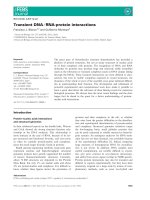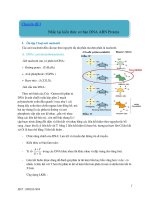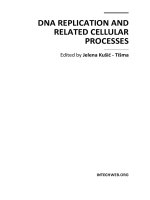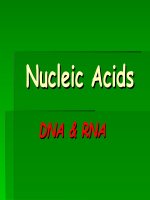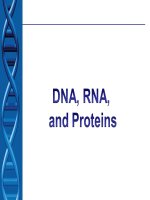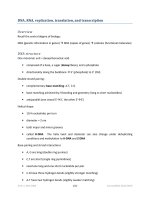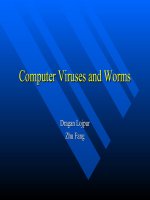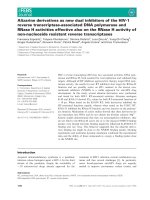DNA, RNA and proteins
Bạn đang xem bản rút gọn của tài liệu. Xem và tải ngay bản đầy đủ của tài liệu tại đây (767.2 KB, 18 trang )
DNA and Protein Synthesis
•
DNA contains the genetic information to
make amino acids
•
Amino acids combine to make proteins
•
These proteins determine the physical traits
of an organism and control cellular functions.
•
Proteins do everything,
and DNA gets all the
credit!
•
Think of them as tiny minions
who do all the work
DNA and Protein Synthesis
DNA and Protein Synthesis
•
Codon: three bases code for a specific protein:
ex: AAA = Lysine
•
The codons code for 20 amino acids
•
Just like the alphabet has 26 letters to make all
the words we know, the 20 amino acids make
all the different proteins found in living
organisms
•
The codons are the template for protein synthesis,
which takes place on the ribosomes (rRNA) in the
cytoplasm
DNA and Protein Synthesis – Codons and amino acids
Name the
Amino
Acid:
UAU
CCG
AGU
GCA
Tyrosine
Proline
Serine
Alanine
DNA and Protein Synthesis
But… How does the
information get from the DNA
to the cytoplasm?
mRNA
DNA and Protein Synthesis - Transcription
Transcription:
1) DNA unzips
2) mRNA (messenger ribonucleic acid) copies info
from DNA using base pairings
•
RNA is different from DNA
a) Single stranded, not double stranded
b) Instead of deoxyribose, it has ribose
c) instead of Thymine, it uses Uracil
3) Carries the genetic code from the nucleus to the
ribosome in the cytoplasm
DNA and Protein Synthesis - Translation
Translation:
1) rRNA (ribosomal RNA) attaches to mRNA and
starts reading the codons
2) tRNA (transfer RNA) – carries amino acids and
attaches them to the growing protein chain
3) When protein production is complete, the
ribosome releases the protein chain
DNA and Protein Synthesis - Summary
DNA and Protein Synthesis
Practice making mRNA using the DNA template
DNA and Protein Synthesis
•
Amino acids are linked together in the same
order as the codons , creating a protein chain
•
Just like linking letters to make words, linking
amino acids makes proteins
Amino
Acid
Amino
Acid
Amino
Acid
DNA and Mutations
Mutations are any changes that take place in DNA:
•
Can be spontaneous or caused by mutagens
•
ex: Chemicals, high temperatures, UV light,
radiation
•
Can change the genetic code, and be replicated
when forming new body cells.
•
In sex cells, can be passed on to offspring.
•
Mutations can be neutral, beneficial, or harmful
•
ex: Blue eyes – a mutation that occurred 6-
10,000 years ago, can be traced back to one
ancestor
•
what kind of mutation is that?
DNA and Mutations – Lets looks at different mutations
THE DOG BIT THE CAT
DNA and Mutations - Substitution
THE DOG BIT THE CAT
•
Substitution - Replace just one letter:
THE DOG BIT THE CAR
DNA and Mutations - Deletion
THE DOG BIT THE CAT
•
Deletion: Delete just one letter (T):
THE DOG BIT HEC AT
DNA and Mutations-Insertions
THE DOG BIT THE CAT
•
Insertion - Add just one letter (E):
THE DOE GBI TTH ECA T
Cells have “proof reading” proteins that constantly
check the DNA and fix errors, so most are corrected
Protein Synthesis- you try it!
DNA transcription and translation- you try it!

